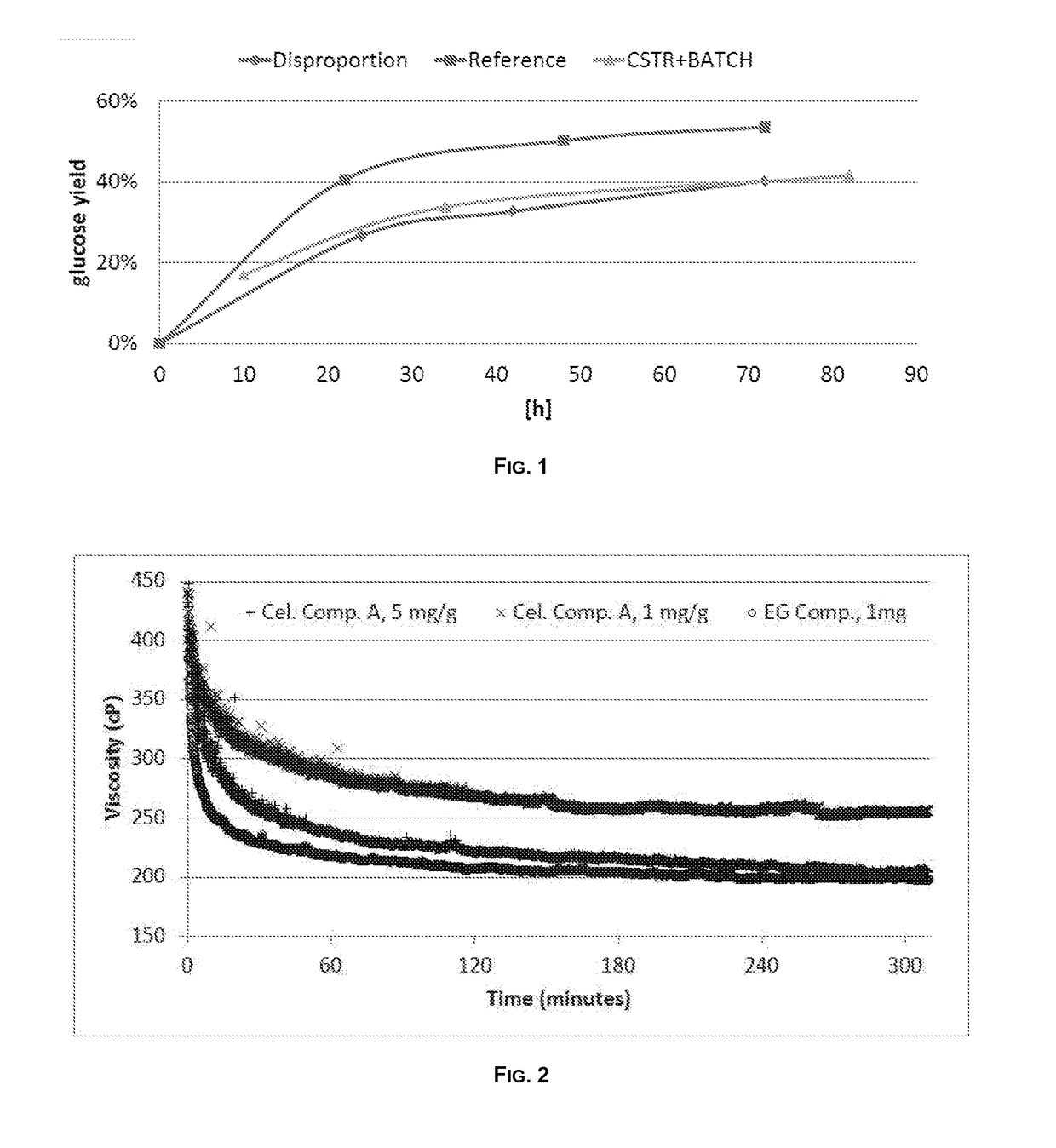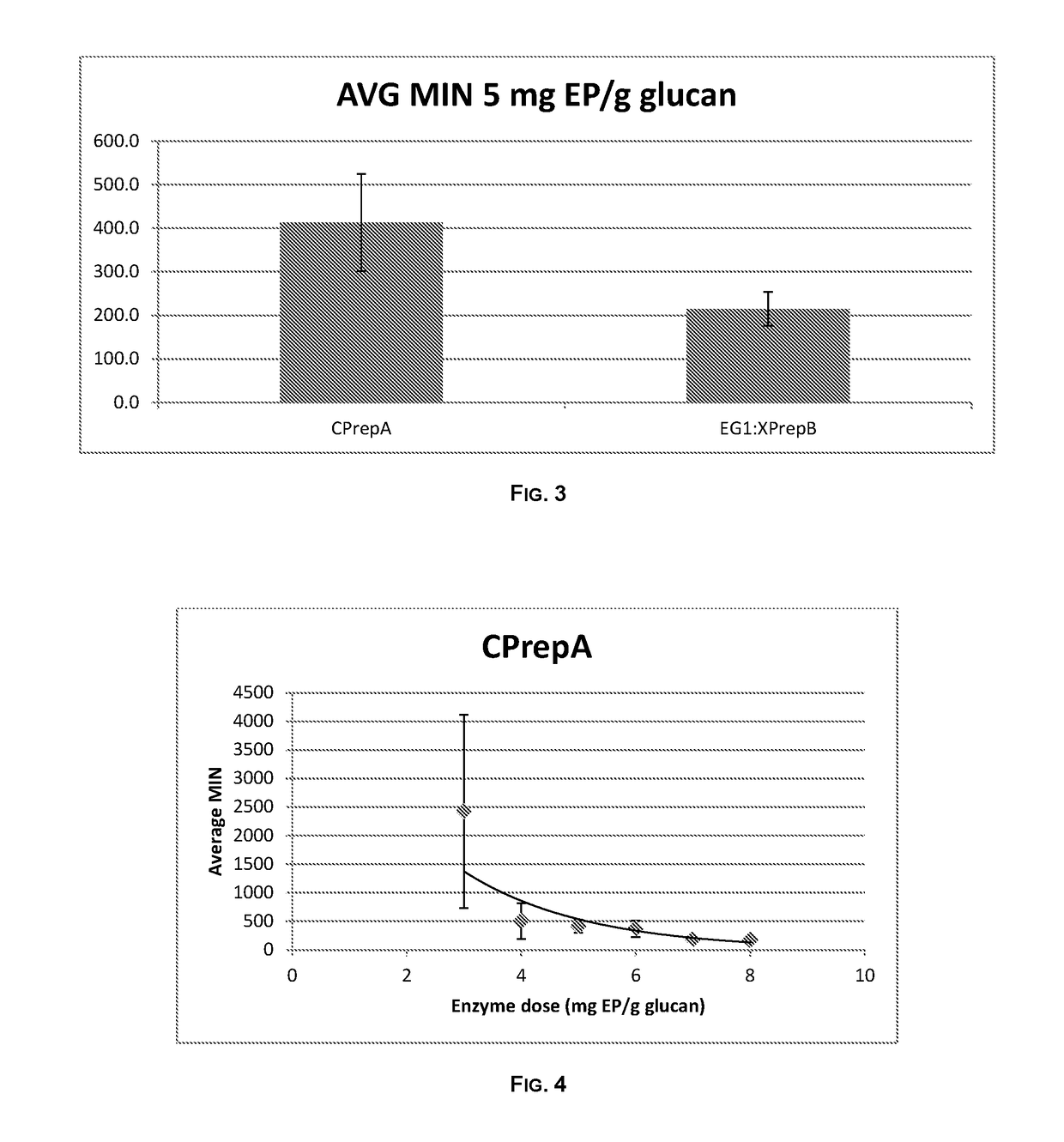Multi-Stage Enzymatic Hydrolysis of Lignocellulosic Biomass
a technology of lignocellulosic biomass and enzymatic hydrolysis, which is applied in the field of multi-stage enzymatic hydrolysis of lignocellulosic biomass, can solve the problems of limited yield achieved, more detailed operations, and limitations, and achieve the effect of improving the yield of resultant sugars and increasing the yield of glucose and/or xylos
- Summary
- Abstract
- Description
- Claims
- Application Information
AI Technical Summary
Benefits of technology
Problems solved by technology
Method used
Image
Examples
example 1
Comparison of Two Stage Hydrolysis with First Step of CSTR vs. Batch
[0316]Wheat straw was introduced into a continuous reactor and subjected to a soaking treatment at a temperature of 158° C. for 65 minutes. The soaked mixture was separated in a soaked liquid and a fraction containing the solid soaked raw material by means of a press. The fraction containing the solid soaked raw material was subjected to steam explosion at a temperature of 200° C. for a time of 4 minutes to produce a solid stream.
[0317]Soaked liquid was subjected to a concentration step by means of a membrane filtration step, which also removes a portion of acetic acid. First, soaked liquids were subjected to a preliminary pre-separation step to remove solids, by means of centrifugation and macro filtration (bag filter with filter size of 1 micron). Centrifugation was performed by means of an Alfa Laval CLARA 80 centrifuge at 8000 RPM. The soaked liquid was then subjected to concentration by means of an Alfa Laval 2...
example 2
Viscosity Reduction with Endoglucanase
[0334]The cellulosic material used for this experiment was corn stover pretreated by steam explosion in the presence of dilute sulfuric acid. The pretreated cellulosic material was supplied by the National Renewable Energy Laboratory (NREL) in Golden, Colo. Total solid content was 21% and the sulfuric acid concentration was approximately 0.8%. The cellulosic material was heated to 180° C. for approximately 5 minutes before being discharged and steam exploded. The pH of the pretreated substrate was adjusted to 5.0 with sodium hydroxide before enzymes were added. After pH adjustment, the total solids content was 22.5%, due to the added salts.
[0335]The reaction was run in a Rapid Visco Analyzer RVA-4 (Newport Scientific Pty. Ltd., ½ Apollo Street, Warriewood, NSW 2102, Australia). This instrument provides a temperature controlled cylindrical compartment with a paddle agitator. Viscosity is deduced from the measured torque of the agitator. The agita...
example 3
Viscosity Reduction with Enzyme Blend of Endoglucanase and Xylanases
[0338]Hydrolysis was performed on pre-treated wheat straw in order to measure apparent viscosity in the biomass slurry. A combination of XPrepB and EG1 was compared to CPrepA with the aim of obtaining more or equal viscosity reduction as a 5 mg EP / g glucan dose of CPrepA.
[0339]The fiber fraction and the liquid fraction of pre-treated wheat straw were combined in a ratio of Liquid / Solid=0.75. During mixing of the solid and liquid fraction the pH of the substrate was adjusted to 5.2 with 2 M potassium hydroxide.
[0340]Hydrolysis was started by weighing the mixed and pH adjusted substrate in to 50 ml centrifuge tubes (LOT:525-0160, VWR International, Radnor, Pa., US) that correspond to a final reaction dry matter of 10%. 1 ml of 1M sodium acetate buffer at pH 5.2 was added to each tube. Double deionized water was added to all tubes so that the final weight of all tubes would be 20 g after enzyme addition. To aid mixing ...
PUM
| Property | Measurement | Unit |
|---|---|---|
| pH | aaaaa | aaaaa |
| pH | aaaaa | aaaaa |
| volume | aaaaa | aaaaa |
Abstract
Description
Claims
Application Information
 Login to View More
Login to View More - R&D
- Intellectual Property
- Life Sciences
- Materials
- Tech Scout
- Unparalleled Data Quality
- Higher Quality Content
- 60% Fewer Hallucinations
Browse by: Latest US Patents, China's latest patents, Technical Efficacy Thesaurus, Application Domain, Technology Topic, Popular Technical Reports.
© 2025 PatSnap. All rights reserved.Legal|Privacy policy|Modern Slavery Act Transparency Statement|Sitemap|About US| Contact US: help@patsnap.com



